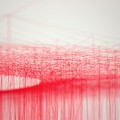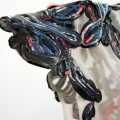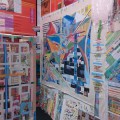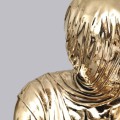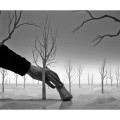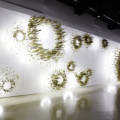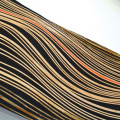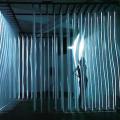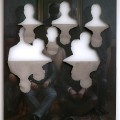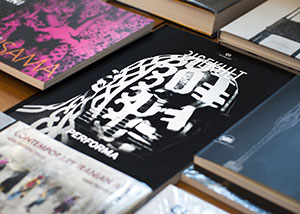Do Ho Suh (b.1962, Seoul, Korea) received a BFA in painting from the Rhode Island School of Design and a MFA in sculpture from Yale University. Suh leads an itinerant life, hopping from his family home in Seoul (where his father, Suh Se-ok is a major influence in Korean traditional painting) to his working life in New York. Migration, both spatial and psychological, has been one of Suh’s themes, manifested through biographical narrative and emotionally inflected architecture. Best known for his intricate sculptures that defy conventional notions of scale and site-specificity, Suh’s work draws attention to the ways viewers occupy and inhabit public space.Interested in the malleability of space in both its physical and metaphorical manifestations, Do Ho Suh constructs site-specific installations that question the boundaries of identity. His work explores the relation between individuality, collectivity, and anonymity. After Korean-born artist Do Ho Suh moved to London a few years ago to be with his wife, he missed his adopted home of New York. He kept a 500-square-foot live-in studio there, in a former sailors’ dorm in Chelsea, and began to contemplate ways of memorializing it. Many of Suh’s most famed sculptures had reimagined his homes—in translucent fabric or resin, or as a painstakingly detailed, oversize dollhouse—from his childhood in Seoul and his young adulthood in the United States. This time, though, he wanted to make a drawing. Except Suh was not content to sit in a chair with a pad and pencil and render what he saw. Instead, he covered every inch of the interior—walls, floors, ceiling, refrigerator, window air conditioner—with paper, then rubbed with a blue-colored pencil, the way a child might preserve the memory of a leaf in the fall. “Rubbing is a different interpretation of space. It’s quite sensuous—very physical and quite sexual,” says Suh, wearing a T-shirt and shorts on a late summer day in his London studio. “You have to very carefully caress the surface and try to understand what’s there.” That dictum could easily apply to the entirety of Suh’s oeuvre, which has explored the varying meanings of space, from the smallest territory we occupy—our clothing—to our homes and homelands. Issues of memory, history, displacement, identity and the body all come into play. In an age of exponentially increasing globalization, Suh’s consideration of what it means to belong strikes a nerve. His almost uncanny ability to hit these major touchstones of our time—and do it with the lyricism of a poet—has made him one of the most internationally in-demand artists of his generation. Suh has fashioned a monumental emperor’s robe from thousands of soldiers’ dog tags and precariously perched a fully furnished house on the edge of a roof seven stories up. He has used his personal history of wearing uniforms—from schoolboy to soldier—as the basis for a self-portrait, and set an army of tiny figurines under a glass floor, inviting viewers to walk on the artwork without necessarily even realizing it. In Suh’s mind, it all has the same origin: “Everything starts from an idea of personal space—what is the dimension of personal space,” says Suh. “What makes a person a person, and when does a person become a group? What is interpersonal space—space between people?” “The whole approach is quite rich,” says Rochelle Steiner, professor at the USC Roski School of Fine Arts, who is working on a book about Suh’s drawings. “He’s been very, very inventive.” With a boyishly round face and a playful grin, Suh looks younger than his 51 years by a decade, but he exudes the seriousness of a veteran artist. It’s a disposition he knows well: His father, Suh Se-ok, is a well-regarded abstract painter in Seoul. After secondary school, the younger Suh had hoped to become a marine biologist, but with a poor math score standing in his way, he applied to art school at the last minute and was accepted. He studied traditional Korean painting before following his first wife, a Korean-American grad student, to the states in 1991. The Rhode Island School of Design (RISD) was the only American art school to accept him, and though he’d already earned a master’s degree in Seoul, RISD insisted he enter as a sophomore. Still, immigrating alleviated some of the pressure of being his father’s son. “I felt relieved when I went to the states,” he says. “I felt much more freedom. I realized the danger of having a father like mine—he’s going to always come up—but in the U.S. my father is nobody.” Asked how his father regards his success, Suh says, “I’m not sure if he feels proud of me. I don’t know if he feels competition. He doesn’t show those things.” At RISD, Suh couldn’t get into the classes he most wanted to take and ended up enrolling in The Figure in Contemporary Sculpture. “It changed the course of my life,” Suh says, adding that the professor, Jay Coogan, “is responsible for my becoming a sculptor.” Presented with the first assignment—use clothing to consider the human condition—Suh delved into ideas about the body, a topic that was taboo in Korea. Around the same time, the Rodney King riots erupted in Los Angeles, and news images of armed Korean immigrants protecting their stores made Suh think for the first time about how non-Koreans perceived his ethnic group. His classmates, he recalls, all younger than he, related neither to the immigrant experience nor to the mandatory military training that every Korean man, himself included, must endure.
Do Ho Suh: Fabric Walls
CREDITS: http://www.wsj.com
VIDEOCOMMENTSRELATED POST |
|
|
|
|
























